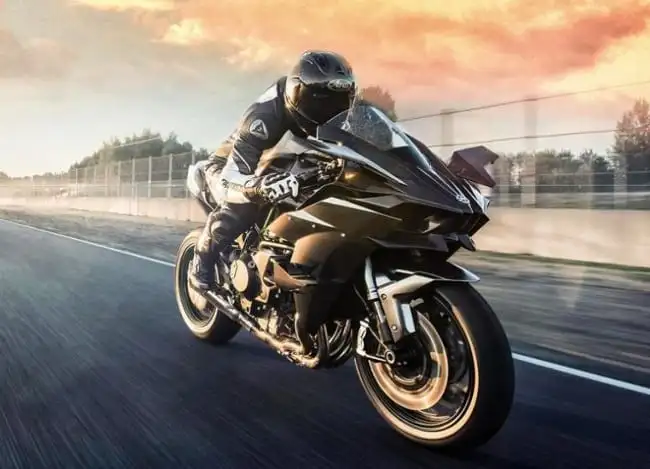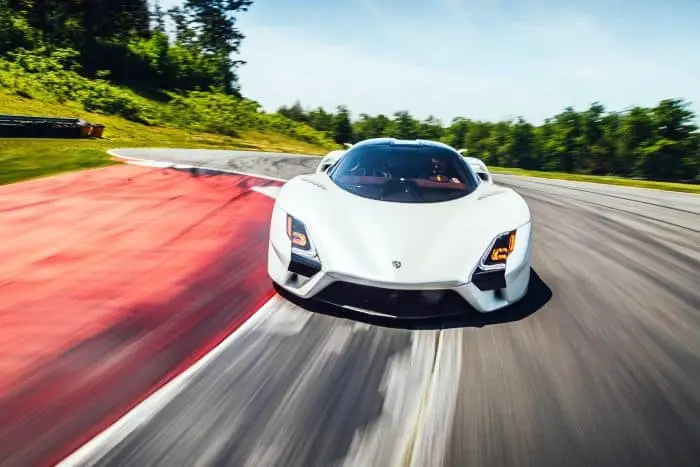We Human beings should be grateful to those brave and brilliant wright brothers for gifting their creation to humanity.
Their invention helped us travel in the sky or gaze at the wonders of exploring space.
Since its use in wars, we pushed the ultimate boundaries of aircraft making, from commercial passenger planes to unmanned aircraft technology.
Now, limiting factors like altitude and speed are irrelevant, thanks to the discovery of jet engines in the latter half of the 20th century.
Military research develops most aeronautics technology like missile systems, fuselage, afterburners, and design in the airforce research facilities.
It’s done for developing better fighter planes that will have an upper edge over enemies.
Hawker Hunter was the fastest jet in the world prototype that broke the world air speed record for aircraft, achieving 727.63 mph in 1953.
In December 1959, Major Joseph W. Rogers set a world speed record for flying an interceptor aircraft Convair F-106 Delta Dart at the fastest speed 1525.96 mph (2,455.79 km/h).
Talking about modern Aeronautics, these machines can easily achieve supersonic speeds quickly.
But how fast do planes fly?
Depending upon the altitudes, fighter jets fly between 650mph to over 1,400mph.
There are many best fighter jets like combat aircraft, Fighter Planes, multirole airplanes, reconnaissance and Surveillance Planes, Attack Planes, or multi-role aircraft.
Among them, we will list out the top 10 fastest aircraft in the world in 2023:
10. Sukhoi Su-27 “Flanker”

The Su-27 (NATO reporting name: Su-27 Flanker) is a Soviet-origin twin-engine supermaneuverable fighter aircraft capable of achieving the speed of Mach 2.35.
This Russian aircraft was designed for air superiority missions; subsequent variants can perform almost all aerial warfare operations.
Soviets built it to counter the new American fourth-gen fighters like the F-15 Eagle or Grumman F-14 Tomcat for air superiority.
It is equipped with a 30 mm gun and ten internal turrets capable of holding air-to-air, heat-seeking, short, and medium-range rockets.
It has many distinct variations for all its achievements and popularity.
Just like the 5th-generation jet fighter Sukhoi Su-57, Sukhoi Su-27 can still be considered a modern fighter even 35 years after the Flanker’s first plane (1977).
9. General Dynamics F-111 Aardvark

General Dynamics F 111 Aardvark is an American supersonic, medium-range tactical attack aircraft and is currently retired.
Not just as a tactical attacker, the aircraft served various versions as a strategic nuclear bomber, aerial recognition, and electronic-warfare aircraft.
The F-111 has several aircraft manufacturing technologies, including variable-sweep wings, turbofan afterburner engines, and low-level automated high-speed radar in field tracking.
Its design influenced later variable sweeping wing fastest airplanes (like Rockwell B-1 Lancer or Grumman F-14 Tomcat) and has since become standard for some of its advanced features.
General Dynamics made this mechanism of variable geometry wings practical through NASA’s simplification.
Variable geometry wings were needed because, by the 1960s, an increase in aircraft weight needed better liftoff design.
Wider wings provided heaver liftoff capacity but with the cost of lower altitudes and speed.
Variable geometry offered top speeds and maneuverability with heavier payloads, long-range capacity, and shorter distance abilities to takeoff and landings.
8. McDonnell Douglas F-15E Strike Eagle

Even today, most people consider the McDonnell Douglas F-15 eagle to be one of the most successful fighter jets and fastest planes ever created, and is still in service today in the U.S. Air Force.
The twin-engine and thrust-to-weight ratio of the Eagle of 1:1 can propel the plane of 18,000 kg to over 2.5 times the speed of sound.
Developed in 1976 (To counter Russian air superiority) and will stay a part of the air force until 2025.
Nearly 1200 F-15s were built and exported to Japan, Saudi Arabia, and Israel, among others.
USAF’s current plan is to continue producing them until 2019. It was first designed as an air-superiority aircraft but was later built as an Air-to-Ground variant, the F-15E Strike Eagle.
The F-15 Eagle can carry on its 11 hardpoints a range of Sparrow, Sidewinder, and 120-AMRAAM crash missiles.
With its 20 mm M61A1 Vulcan gun and fastest speed, it is no surprise that this fighter jet has over 100+ confirmed aerial combat victories.
7. Mikoyan MiG-31 “Foxhound”

Mikoyan-Gurevich designed the plane as a replacement for the earlier MiG-25 “Foxbat.”
The MiG-31 is based on and shares design elements with its predecessors, MiG-25 and MiG-29.
MiG-31 distinguishes itself as one of the world’s fastest jet plane before and even now. It can fly at high altitudes at high speeds up to Mach 2.83 (2171.372 mph).
Its D30-F6 jet engines, each rated at a 152 kN thrust, allow the speed of Mach 1.23 (932 miles per hour) at low altitudes.
The MiG-31 was one of the first planes with a phased array radar system, and as of 2013, it was one of two fighter jets capable of freely firing long-range air-to-air missiles.
It was also the first operational fighter with the Zaslon S-800, a passive electronically scanned array radar (PESA).
Its maximum reach against fighter targets is about 200 km, and it can track up to 10 objectives and strike four of them simultaneously with its Vympel R-33 rockets.
The aircraft was in production from 1975; the Russian Air Force and Kazakhstan Air Force are still using MiG-31 and will remain in service until or beyond 2030.
6. North American XB-70 Valkyrie

The XB-70 Valkyrie North American Aviation was a USAF nuclear-armed prototype model, deep-penetration strategic bomber.
At the end of the 1950s, the Soviets introduced the first surface-to-air missiles, which threatened the B-70’s invulnerability.
Thus, The United States Air Force (USAF) conducted their missions at low altitudes, where the missile radar’s line of sight was limited to geographical features of the terrain.
The B-70 offered little additional performance in this low-level penetration role over The B-52, which was supposed to be replaced while being far more expensive with a low range.
To more effectively use the higher pressure field behind the powerful shock wave, the wing was built into an inboard camber at much higher speeds.
The outer sections of the aircraft wings were hinged and could be pivoted downward by up to 65 degrees, acting almost as a variable-geometry wingtip device.
This improved directional stability at supersonic velocities shifts the center to a more favorable position at top speeds and enhances the compression lift effect.
5. Bell X-2

The Bell X-2 “Starbuster” was an American research fastest aircraft flying for the first time in 1955 and retired in 1956.
It was a part of the X-2 program, and so its research division was to see how the Supersonic aircrafts behaved at altitudes with speeds greater than Mach 2.0 when traveling.
Its Predecessor, Bell X-1 was the first manned airplane to exceed the speed of sound in level flight.
With no weapons like the missile launch system, it featured a back-swept wing that created low air resistance and prepared to meet the speed of Mach 3.196 in 1956.
Accidentally, the supersonic flight pilot made a sharp turn soon after he reached very high speed, and then it crashed out of control.
He lost control and bailed out. Unfortunately, the rescue shuttle’s tiny parachute was only launched, and he thumped the floor too fast.
The Starbuster program ended with this deadly collision.
4. Mikoyan-Gurevich MiG-25 “Foxbat”

This Soviet aircraft constructed was among the fastest military jet in USSR.
It entered service among flights to attack American fighter planes during the cold war, such as the blackbird and high-slow moving surveillance aircraft.
Since the Russians intended to attack, excessive speed was the need, hence its maximum speed of Mach 3.2.
Unlike the Blackbird, the Foxbat could carry four air-to-air missiles and unguided gravity bombs with a rudimentary strike capability that made it an interceptor rather than a surveillance plane.
It has never fired down a Blackbird, but it has had many other effective fighting missions, for example, in the conflict between Iran and Iraq.
Between 1964 and 1984, over 1100 Foxbats were built, but today it’s limited in use, with Russia, Syria, Algeria, and Turkmenistan being the only consumers.
Just like, MiG-29 Fulcrum, Mikoyan MiG-25 was used in Edge of Space Stratospheric Jet Flights.
3. Lockheed YF-12

The Lockheed YF-12 was an American prototype interceptor aircraft by Lockheed Martin assessed in the 1960s by the U.S. Air Force.
YF-12 just appeared like the Blackbird, which has three Air-to-Air missiles.
It is because they modeled the SR 71 on the YF-12 and because they both had the same designer, Clarence Johnson, “Kelly.”
It is the biggest, heaviest, and fastest interceptor plane in the world to date.
But has also set and maintained speed records at an altitude of over 2000 miles per hour (3,200 kph) and over 80,000 feet (24,000 m) (later surpassed by SR 71 blackbird).
2. Lockheed SR-71 Blackbird

Even after 57 years after its first flight, Lockheed SR-71 Blackbird remains the fastest fighter jet in the world ever built and used by both USAF and NASA.
Americans built 32 Blackbirds and used them for reconnaissance and experimental research.
It showcased stealth technology; even if enemy fighter planes were detected, this plane could escape easily because of its astonishing speed.
This stealth fighter could easily surpass the interceptors or surface-to-air missiles launched toward it.
During test flights, it was able to cruise near the edge of space and outfly a missile.
The plane also holds the record for the achieving highest altitude of 85,069 ft in horizontal flight with a turbojet engine, a record achieved on July 28, 1976.
Blackbird was so fast that there was no time for air in front of it to glide, thus increasing pressure near its nose, which increased its internal temperature by too much friction.
The fighter jet’s temperature would sometimes reach very high, which expanded the metal, so it had to be built with small parts. Because of this, when standing still, the SR-71 spilled oil.
But how fast is the fastest jet?
SR–71 Blackbird is capable of flying at maximum speeds of Mach 3.3 (around 2,193.2 mph).
Its successor, the new-72 hypersonic spy unmanned aircraft is projected to reach Mach 6 or just 4,500 mph.
1. North American X-15

As part of the X-plane series of experimental aircraft, the US Air Force and NASA operated the hypersonic rocket-powered aircraft X-15.
With a top speed of 4520 mph, North American X-15 is still the fastest plane in the world in 2021 that carried a human, a speed record unbroken by this day.
This rocket jet’s speed is just surpassed by experimental drones, NASA X-43A and HTV-2 Falcon.
Its top speed was Mach 6.70 (about 7,200 kph), which was achieved by a pilot qualified as an astronaut William J Chevalier on October 3, 1967.
To stabilize the aircraft at super-high altitudes, designers in a big wedge tail with small-width wings.
But the downside of this was that the drag from such a tail was enormous at the lower altitude.
A B-52 mothership had to carry it to an altitude of 14,000 meters approximately, after which X15 ignited its engines before being drop launched.
Rocket thrusters were used to steer X15 as the plane operated at such extreme speeds.
Using traditional steering methods (rudder) could prove fatal (as the force would merely rip off or disturb its directional velocity).
All these factors enabled elevations of over 100 kilometers to be reached, which was one of its world records.
X-15 overall has these three world records:
1. It was the first operational spaceplane.
2. It got to a height of over 100 km.
3. It flew over six times the speed of sound (Mach 6.70).
If you liked this post about the fastest military aircraft in the world, share this with your friends on social media.










Regarding X15 I have a doubt..
If it flies at so high altitude why are its so small..
On contrary it should be big
its smaller so it has a larger thrust to weight ratio do it can go faster and at those heights it uses something called RCS which is basically smaller rockets positioned around the aircraft to help in turn and maneuver in low vacuum atmosphere.
Thanks Caden for explanation,
According to me,
Having bigger wings increases the drag coefficient (aerial friction) which in turn can reduce the speed (the plane’s only purpose).
The first one literlally like a rocket, a NASA’s or spaceX horizontal flying rocket
nyc artical
Awesome. Supercool.loveit!!!!!!!!!!!!
thanks for the info. Loved it.I want to be in the military AIR fORCE!
!!1. Boeing will mfg. an rocket power plane too! It will have an nuclear twin engine Rocket engine too! It will carried Passengers into space to Space Station too. Then to earth to the at the Space port too! By 2049 A.D. too!